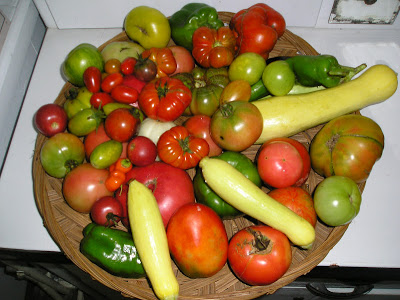 |
| Rosemary in window-Turn 1/4 every few days to keep growth even (B.Petrucci) |
When my family, friends and neighbors ask me (the Master Gardener) about caring for their houseplants I try to answer without laughing.
Outside my door, plants thrive; however, my house is just hospice care for houseplants. I am just about to lose an aloe plant that has lasted since 2009. I'm really, really sure it needs to be repotted.
For the tender perennials I bring inside in winter, my rosemary particularly, my goal is to keep it alive until I can put it back outside.
From Master Gardeners I have learned a few key things, so here is my quick tip list followed by a number of great resource sites. It is important to check the needs of each plant since they can vary greatly.
1. Be sure the plant is potted in the right size container (with a drainage hole) and right potting soil.
If you are digging it up and dragging it in from the outdoors then potting it up, don't use garden soil. It's too heavy.
2- Water only as needed when the soil is dry.
Water from the top until water comes out the drainage hole (You do have a drainage hole, right?) into the saucer. About two hours later, drain any excess water from the saucer. Don't allow the roots to stand in water. If you don't see drainage but have watered well, check for a clog in the hole and clear it. Inconsistent watering is one of the primary reasons for plant loss.
3- Use room temperature water.
Leave tap water out overnight, uncapped or uncovered, to allow the chlorine and fluorine added to city water to dissipate. Although these probably don't harm plants, you want the water to be at room temperature anyway. Rainwater, snow melt and well water are ok. Don't use water run through water softeners.
4- Light should be appropriate for the plant.
Each plant is different - flowering plants need moderate light, some foliage plants do well in low-light areas but other need more. Rotate plants near windows to allow for even growth. Improper lighting is only secondary to poor watering practices for plant failure. See below about light level definitions.
5- Humidity indoors in the winter is low.
Use a water-tight tray with constantly moist sand or gravel in it under the plants. Do not put the pot IN the tray. Put the pot with saucer ON the tray. Misting leaves daily can help with low humidity but some plants such as orchids or gardenias need special care. Check sources for help on these.
Be expecially mindful of tender perennials that you have brought in from outdoors to overwinter in areas where you may still be running dehumidifiers, such as basements or lighted storage areas.
6- Temperature needs of different plants vary.
Be careful putting plants near windows for the light. These areas might be cold spots or hot spots, especially if they are sited near radiator or heat sources. Although some indoor plants will tolerate cooler rooms, most like temperatures 65° – 75°F.
7- Fertilizer once a month with water-soluable complete fertilizers.
For most plants winter is not a growth period so fertilize lightly. For tender perennials brought indoors, do not prune as this may stimulate growth. Typically, plants in our area use winter (shorter days, longer nights) to go dormant so anticipate slower growth and let the plant rest up. If you have indoor flowering houseplants, check the needs for each individual type. Some may need a healthier dose of fertilizer.
Indoor Light Definitions
Here is a good list of indoor light definitions I found that coincide with information gleaned from different Extension sources. I have not reformatted the information provided by Will Creed (http://en.allexperts.com/q/House-Plants-721/Light-level-definitions.htm).“The low/medium/high categories are somewhat vague and overlap considerably, so there is no rigid definition for them. Below is my [Will Creed] best effort to bring some clarity to these terms.
High light plants must have some direct sunlight for at least several hours per day and bright indirect light for the rest of the day. South and west facing windows are the best locations for these plants.
Medium light plants must have bright indirect light all day long and can often tolerate a couple of hours of direct sunlight. East and north facing windows are the favored locations for these plants.
Low light plants must be protected from direct sunlight at all times. They thrive in bright indirect light, but will often tolerate minimum light levels. These plants prefer locations close to a north window or away from an east, west, or south facing window where they are protected from the direct rays of the sun.”
Here's some links with more houseplant care tips:
Penn State Extension: Caring for Houseplants
Missouri Extension: Caring for Houseplants
West Virginia Extension: Caring for Houseplants
George Weigel: Houseplant Myths
Horticulture Help: Indoor Plants
Iowa State Extension: Take Care of Indoor Plants during Winter
Cornell Extension: Houseplants




No comments:
Post a Comment